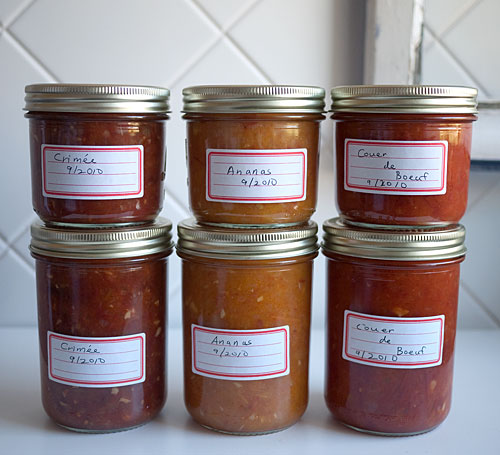
Minimalist tomato sauce, made from a single variety of heirloom tomatoes.
Filed under:
preserves and pickles vegetables summer low-carb
3 years ago, I mentioned a handy list of produce ranked by how much pesticide is used to grow them. The higher (=more pesticides) the ranking, the better it would be to stick to organically grown.
I recently got a new iPhone (yes...I'm the very opposite of an Early Adopter of tech gadgets) and discovered that the same list is available as a free iPhone app called DirtyProduce. Here's a screenshot of the opening page:

It doesn't do much beyond list the Dirty Dozen (the most heavily pesticide-treated fruits and vegetables), the Clean 15 (the last pesticide-used) and the full list of 47 produce items, but it's handy to have around with you. Who knew for instance that peaches were the most pesticide-laden fruit or vegetable? I tend not to peel my peaches, and I ate, oh I don't know, a few tons of them over the summer. I may start peeling them next season, or look for non-treated ones.
Anyway, if you do have an iPhone, take a look. And if you don't, there is still the PDF list to print out and carry in your wallet.
Filed under:
fruit vegetables ethics shopping

It's still summertime, but I can feel the cooler days of fall coming, especially in the evenings when the temperature is dropping just a bit more than it did a few weeks ago. This is one of the best times of the year for food lovers, especially if you love vegetables.
Eggplants (aubergines) are in high season now and will be around for at least another month or so. While you can get them year-round, they are at their best of course in their natural season.
This is a classic Japanese way of serving eggplant, and it's really easy. All you do is to slowly roast the eggplant until tender, either in the oven or on the stovetop in a frying pan, then serve with a glossy, salty-sweet dengaku (田楽)sauce. I could eat this every day, with a bowl of plain rice and some cold mugicha to wash it down.
Filed under:
japanese vegetables fall vegetarian summer vegan eggplant

We left Provence this week for a little trip to the Midi-Pyrénées in the southwestern part of France. We've been trying to save money by cooking at home most of the time since we started our nomadic existence in France (see previously; not that that's much of a hardship, since the produce and other foodstuffs in Provence are spectacular). But this week we've been staying in an apartment in a 17th century townhouse right around the corner from the Toulouse-Lautrec Museum in the heart of Albi, the capital of the Tarn Department. Since there are tons of great little restaurants here, we've been indulging ourselves a bit.
Filed under:
food travel soup vegetables summer france

I've never really been good at making tempura, the quintessential Japanese deep fried dish. My mother's tempura has always been terrific - crispy, light, and not greasy at all. So, taking advantage of her extended vacation here this year, I drilled her properly on how she makes tempura.
Her method does not rely on special tempura flour (cheap in Japan but expensive or hard to get a hold of elsewhere), or other recently touted additions like vodka or other high-alcohol liquor, so anyone should be able to do it. Just follow the key points listed below.
Filed under:
japanese vegetables vegetarian washoku

Lotus root (renkon in Japanese) is actually the rhizome of the lotus plant. It's a popular vegetable throughout southern and eastern Asia, but it's still not that well known in the west. Lotus root is full of fiber and various vitamins and other nutrients. In Asia it's believed to have various medicinal qualities, but in macro-nutrient terms it's best to think of it as a starchy vegetable, like potato. Visually of course, it's very appealing with all those little holes. Here I'll explain how it's prepared and eaten in Japan.
Filed under:
basics japanese vegetables vegan

I have talked about konnyaku before, the almost zero calorie, rubbery-jellylike food that makes me really wonder at the ingenuity of people of the past. Why would they think that an almost flavorless, almost nutrient free substance would be edible?
Well, konnyaku is not about its innate flavor - it's all about texture. And since it realy has so little calories, it's a great addition to meals for the dieter, giving a feeling of fullness.
Here are a couple of easy and traditionally Japanese side dishes uses konnyaku. Konnyaku no tosani is konnyaku that is cooked in a flavorful liquid and tossed with plenty of katsuobushi (bonito flakes). __Konnyaku kinpira_ is konnyaku sautéed with sesame and chili pepper.
I tend to make konnyaku dishes when I want to really watch the calories, but still have a hearty appetite.
Filed under:
japanese lighter washoku vegetables kinpira
Submitted by maki on 13 October, 2008 - 16:29

Following up on the previous post where I asked about your favorite go-to everyday dishes (keep your ideas coming!) I thought I'd introduce some of mine. The posting of them may be sporadic, since I'll be taking pictures and things when I actually made them for dinner.
First up is something that is very easy to assemble, quite healthy, cheap, as seasonal as you want it to be, and almost infinately variable. It's simply roasted vegetables. I make this all the time, throughout the year, using whatever vegetables I have. It's a good refrigerator-clearer too.
Type:
recipe Filed under:
basics vegetables vegetarian favorites
Pages